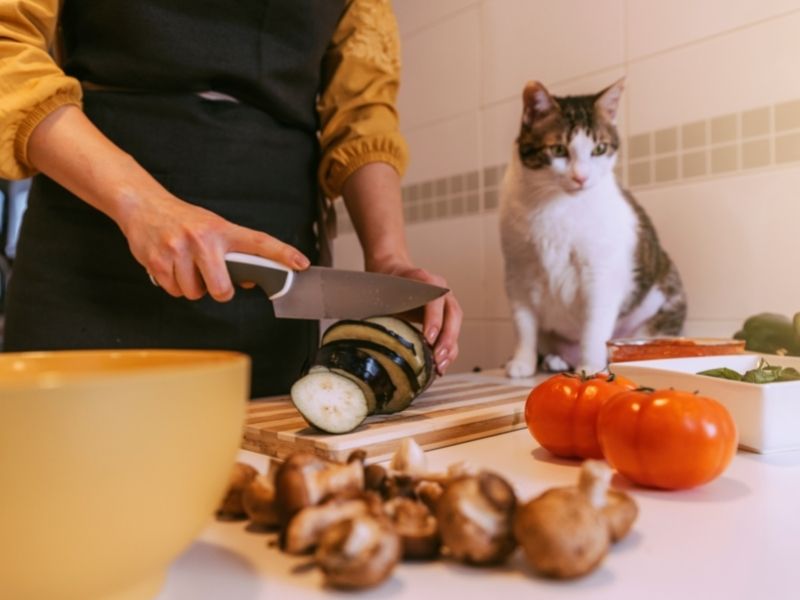When you’ve decided on bringing home a rescue cat, you’ll need to prepare a starter kit that includes feeding and drinking bowls as well as complete and balanced food and treats that meet her nutritional needs. Aside from feeding your cat age-appropriate meals, you can occasionally feed her fresh produce found in your kitchen. In this blog post, we discuss:
- What foods do cats typically eat?
- What can I feed a cat?
- Fruits a cat can eat
- Vegetables a cat can eat
- Other considerations when feeding fruit or vegetable to a cat
What foods do cats typically eat?
Unlike dogs, cats are obligate carnivores that need to consume animal-derived protein and fat on a daily basis. Meat contains essential nutrients (such as taurine, arachidonic acid, vitamin A, and vitamin B12) and chemicals that cats cannot get from eating plant-based food. Plus, their stomachs don’t have the capacity to digest plant-derived meals properly. Therefore, it is impossible for cats to become vegetarians or vegans since plants do not provide the right amount of amino acids they need to thrive.
What can I feed a cat?
With your veterinarian’s guidance, you can feed your cat a mixture of dry kibble and wet canned food split into smaller meals per day. Always give her cat food made from high-quality ingredients so she doesn’t end up vomiting. On top of these meals, you can also offer her fruits and vegetables to snack on that have been approved by your vet. Snacks should be limited to 10% of her daily calories, with each fresh produce having a recommended serving size. Be careful not to give your cat too much vegetable or fruit since some of these may upset her stomach. Symptoms may manifest as lip licking (an indicator of nausea), vomiting, refusing to eat, and/or diarrhea.
Fruits a cat can eat
Fruits are defined by the Merriam-Webster dictionary as “the edible reproductive body of a seed plant.” These delicious treats can be eaten in their raw state, and typically have sour or sweet flavours. It is interesting to note that cats do not have the capacity to taste sweetness, so this should not be your primary reason for letting a cat try a particular fruit.
Before giving your cat a fruit, wash it properly and remove rotten or moldy parts. The peel, pit, and/or seeds should also be taken out and discarded properly. Cut the edible portions into bite-sized pieces that your cat can safely chew and swallow.
Fresh fruits such as apple, blueberries, mango, pineapple, strawberry, and watermelon may be consumed by your cat in limited quantities, while avocado, banana, grapes, and tomato must be avoided. Canned fruits should not be fed to your cat since they may contain high levels of sugar and preservatives.
Vegetables a cat can eat
Vegetables are “parts of plants that are consumed by humans or other animals as food.” It typically includes the plant’s seeds, roots, stems, leaves, and flowers. Similar to fruits, vegetables should be washed and their spoiled parts should be removed. Hard, inedible parts such as the seeds, core, and stalk should also be taken out.
Prevent choking by serving your cat cooked vegetables that have been chopped into smaller pieces. Make sure to cook the vegetable without adding harmful ingredients such as salt, butter, and oil. You can boil, steam, blanch, or grill the vegetable, making sure it is soft enough for your cat to chew.
Cat-friendly vegetables include broccoli, carrot, corn, lettuce, peas, potato, pumpkin, spinach, and sweet potato. On the other hand, it is not advisable to feed your cat garlic, mushroom, and onion.
Other considerations when feeding fruit or vegetable to a cat
If you’re interested in adding a fruit or vegetable to your cat’s diet, do a quick search on ASPCA to check if it is a toxic or non-toxic plant. Consult with your veterinarian before letting your cat try it for the first time. You want to make sure that the fruit or vegetable does not aggravate existing health conditions she may have. Additionally, make sure your cat is not allergic or intolerant to the produce.
When feeding your cat a vegetable or fruit for the first time, give her one tiny piece first. Observe her behaviour and litter box habits for the next 24 hours. Do not combine it with another new food or any major environmental changes, so you can closely monitor the effects of the produce on her system.
Which fruits and vegetables has your cat tried and enjoyed eating? Let us know by sharing your experiences in the comment section below. Learn more about other human food cats and dogs can safely eat by exploring our blog.

